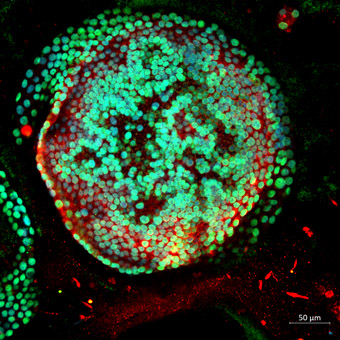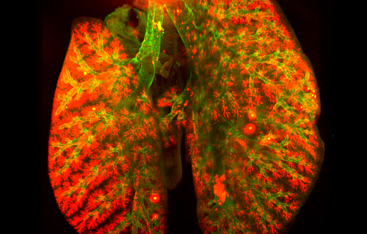How toxic are industrial nanoparticles in the lungs?
An animal-free method could help in the production of safe materials.
It has been sufficiently researched that the finest particles such as cigarette smoke or environmental combustion pollutants damage the lungs. Research has shown that the intricate structure of our lungs becomes a disadvantage when inhaling pollutants: The finely branched and sensitive alveoli of the distal lung are unable to counteract equally fine but harmful nanoparticles. Even the single contact can cause inflammation and prolonged or repeated exposure can lead to chronic diseases such as COPD or lung cancer.
In industrial settings, hazardous nanoparticles can also be released during production and processing or later during the decomposition or combustion of materials. These materials include, for example, ceramic particles for paints or carbon for the production of car tires and other black plastics.

What consequences does the nanoform of these materials cause in the lung and how could harmful effects be predictively assessed and thus be reduced or eliminated? DZL-PI Dr. Tobias Stöger, together with a European research group, has now made two important breakthroughs in this research area:
- Discovery of two previously unknown cellular key events when nanoparticles meet lung cells
- Development of an alternative, animal-free method to predict the acute or chronic toxicity of nanoparticles in the lung for 15 different materials.

The ultimate goal: facilitating the development and production of safer by design industrial materials so that pulmonary hazards can be preemptively eliminated.
Observing nanoparticles outside the lungs
Lung scientists in general face a challenge: they cannot observe cellular processes in the lung in real time and in living humans. So what exactly happens when lung cells and nanoparticles meet? They have to simulate this outside the human body with the help of cell based experiments. One of the difficulties, however, is to determine exactly which and how many particles impact experimentally on the lung cells. To address this though task, the Stöger lab teamed up with DZL-PI Otmar Schmid (also DZL site Munich) who has developed a model to precisely dose the impact of particles in specific regions of the lung and thus on specific lung cells.
Lung cells quarantine particles
Another EU-wide and interdisciplinary collaboration focused on the inflammatory response in the lung. Within the EU project "SmartNanoTox", scientist found out how lung cells react to certain metal-oxide nanoparticles:
1. Lung epithelial cells coat the particles with molecules and deposit them on the cell surface, sending them "into quarantine", so to speak.
2. If phagocytes (lung macrophages) are present, they take up the coated particles and die, depending on the toxicity of the particles. This creates a nanomaterial cycle of ingestion and excretion of nanoparticles, which is maintained by constantly immigrating phagocytes.
The scientists, led by Tobias Stöger, were now able to experimentally check how lung cells react to 15 different materials. This approach enabled them to predict an acute or persistent inflammatory reaction induced by which material. This knowledge base should help industry in the future to produce materials that are as "lung-friendly" as possible.
Last but not least, Tobias Stöger's group has thus developed an alternative, non-animal method for toxicological studies within this project. Their cell based method could be used in the future to test “safety by design” materials without animal testing.


